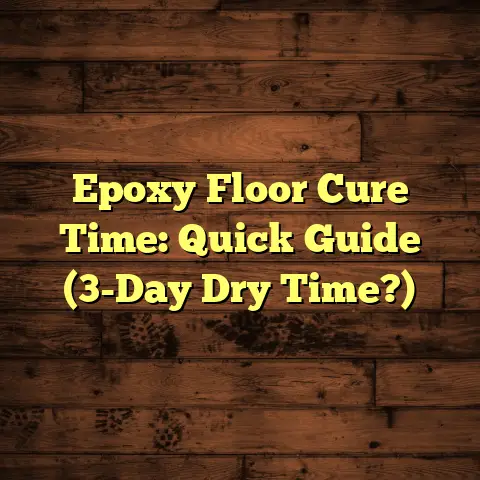Cleaning Floating Laminate (3 Secrets Revealed!)
“Cleaning and organizing is a practice, not a project.” – Meagan Francis.
As a flooring contractor for over 15 years, I’ve seen it all – the good, the bad, and the downright disastrous when it comes to floor care. And believe me, I’ve rescued my fair share of laminate floors from the brink!I’ve seen everything from floors ruined by harsh chemicals to floors neglected to the point of no return.
Today, I want to share some secrets I’ve learned over the years to help you keep your floating laminate floors looking their absolute best.
Section 1: Understanding Floating Laminate Flooring
Definition and Characteristics
So, what exactly is floating laminate flooring? Unlike traditional hardwood that’s nailed or glued down, floating laminate clicks together and sits on top of an underlayment.
Think of it like a giant, interlocking puzzle!
This construction method is what makes it “float.”
It’s different from other flooring types like:
- Hardwood: Solid wood planks, usually more expensive and requires professional installation.
- Tile: Durable, water-resistant, but can be cold and hard underfoot.
- Vinyl: Water-resistant and comes in various styles (sheet, tile, plank), often glued down.
Laminate’s structure is pretty cool. It’s made of several layers:
- Wear Layer: The top, transparent layer that protects against scratches and stains.
- Design Layer: A high-resolution image that mimics wood, stone, or tile.
- Core: A dense fiberboard (usually HDF – High-Density Fiberboard) that provides stability and impact resistance.
- Backing: A bottom layer that provides moisture resistance and balances the board.
The benefits of floating laminate are clear:
- Affordability: Generally cheaper than hardwood or tile.
- Ease of Installation: DIY-friendly click-lock system.
- Versatility in Design: Available in countless styles and colors.
I remember one client, Sarah, who wanted the look of hardwood in her basement but was worried about moisture. Laminate was the perfect solution!
Common Challenges
Now, let’s talk about the downsides.
Laminate isn’t invincible. Homeowners often face these issues:
- Scratches: From pets, furniture, or dropped objects.
- Stains: From spills, pet accidents, or tracked-in dirt.
- Water Damage: Especially around seams, causing swelling or warping.
I’ve seen firsthand how quickly water can ruin a laminate floor. A small leak under a sink can cause major damage if left unchecked.
In fact, a study by the North American Laminate Flooring Association (NALFA) found that water damage is the leading cause of laminate floor failure.
That’s why proper cleaning and preventative measures are crucial!
Section 2: The Importance of Regular Cleaning
Why Clean Floating Laminate?
Okay, I know cleaning isn’t anyone’s favorite activity. But trust me, when it comes to laminate, it’s worth the effort.
Here’s why:
- Aesthetic Benefits: Clean floors look beautiful and inviting, instantly boosting your home’s appeal.
- Health Benefits: Removing dirt, dust, and allergens creates a healthier living environment, especially for those with allergies or asthma.
- Longevity: Regular cleaning prevents dirt and grime from scratching the wear layer, extending the life of your floor.
Think of it this way: your laminate floor is an investment. Cleaning it is like giving it a regular check-up to ensure it stays healthy for years to come.
What Happens If You Don’t Clean?
Neglecting your laminate floor can lead to some serious problems:
- Dullness: Dirt and grime buildup can make your floor look cloudy and lifeless.
- Wear: Abrasive particles trapped on the surface act like sandpaper, gradually wearing down the wear layer.
- Allergen Buildup: Dust mites, pet dander, and other allergens can accumulate, triggering allergies and respiratory issues.
I’ve seen floors so neglected that they looked like they were decades older than they actually were.
The wear layer was completely scratched and faded, and the seams were filled with dirt. It was a sad sight!
Plus, a dirty floor can actually increase the risk of slips and falls. Grime can make the surface slippery, especially when wet.
Section 3: The Three Secrets to Cleaning Floating Laminate
Alright, let’s get to the good stuff!
Here are my three secrets to keeping your floating laminate floors sparkling clean and looking their best:
Secret #1: The Right Cleaning Products
This is where many people go wrong.
Using the wrong cleaning products can actually damage your laminate floor.
Avoid anything too harsh or abrasive.
The DOs:
- Laminate-Specific Cleaners: These are formulated to be gentle yet effective on laminate floors. Brands like Armstrong and Bona are popular choices.
- DIY Solution (Water & Mild Dish Soap): A few drops of dish soap in a bucket of warm water can work wonders. Just make sure to use a very small amount of soap!
- DIY Solution (Rubbing Alcohol & Water): Mix 1/2 cup of rubbing alcohol with 1 liter of water for a streak-free clean.
The DON’Ts:
- Vinegar: Despite being a popular natural cleaner, vinegar can dull the finish of laminate floors over time.
- Bleach: Harsh chemicals like bleach can damage the wear layer and fade the design.
- Abrasive Cleaners: Avoid scouring powders, steel wool, or anything that can scratch the surface.
- Steam Mops: The high heat and moisture can penetrate the seams and cause the core to swell.
I once had a client who used a steam mop on her laminate floor, thinking it was a safe and effective way to clean.
Within a few months, the floor started to buckle and warp. It was a costly mistake!
Secret #2: The Best Cleaning Tools
Having the right tools makes all the difference. Here are my go-to cleaning tools for laminate floors:
- Microfiber Mop: These mops are gentle, absorbent, and effectively trap dirt and dust. Look for a mop with a swivel head for easy maneuverability.
- Microfiber Cloths: Perfect for dusting, spot cleaning, and drying the floor after mopping.
- Vacuum Cleaner (with soft brush attachment): Use a vacuum to remove loose dirt and debris before mopping. Make sure to use the soft brush attachment to avoid scratching the floor.
- Spray Bottle: For applying cleaning solutions.
Why these tools work:
- Gentle: Microfiber is non-abrasive and won’t scratch the surface.
- Effective: Microfiber cloths trap dirt and dust more effectively than traditional cloths.
- Versatile: These tools can be used for both dry and wet cleaning.
I always recommend investing in high-quality microfiber cloths and mops.
They’ll last longer and do a better job than cheaper alternatives.
Secret #3: The Proper Cleaning Technique
Now, let’s put it all together! Here’s my step-by-step guide to cleaning floating laminate floors:
- Prepare: Remove any loose dirt and debris by sweeping or vacuuming the floor.
- Mix Cleaning Solution: Prepare your chosen cleaning solution according to the instructions.
- Dampen Mop: Dip your microfiber mop into the cleaning solution, then wring it out thoroughly. The mop should be damp, not soaking wet.
- Mop the Floor: Mop the floor in sections, using a back-and-forth motion. Overlap each pass slightly to ensure you cover the entire surface.
- Dry the Floor: Use a clean, dry microfiber cloth to dry any remaining moisture. This will prevent water spots and streaks.
- Spot Clean: For stubborn stains, spray a small amount of cleaning solution directly onto the stain and wipe with a clean microfiber cloth.
Frequency of Cleaning:
- High-Traffic Areas: Clean once a week.
- Low-Traffic Areas: Clean every two weeks.
- Spot Clean: As needed for spills and messes.
Tips for Specific Stains:
- Pet Accidents: Clean immediately with an enzymatic cleaner designed for pet stains.
- Food Spills: Wipe up immediately with a damp cloth.
- Grease: Use a degreasing cleaner or a mixture of dish soap and water.
- Ink: Try rubbing alcohol or a specialized ink remover.
I always tell my clients to act fast when it comes to spills. The longer a stain sits, the harder it will be to remove.
Section 4: Preventative Measures
Keeping Your Floors Pristine
Cleaning is important, but prevention is even better! Here are some tips to keep your laminate floors looking their best:
- Use Furniture Pads: Place felt pads under the legs of all furniture to prevent scratches.
- Use Area Rugs: Place area rugs in high-traffic areas to protect the floor from wear and tear.
- Proper Footwear: Encourage family members and guests to remove their shoes or wear soft-soled slippers indoors.
- Doormats: Place doormats at all entrances to trap dirt and debris before they enter your home.
- Regular Sweeping/Vacuuming: Sweep or vacuum your floors regularly to remove loose dirt and debris.
I’ve seen clients who were meticulous about preventative measures, and their floors looked brand new even after years of use.
A little bit of prevention goes a long way!
Long-Term Care
Here are some long-term care practices to keep your floating laminate floors in tip-top shape:
- Humidity Control: Maintain a consistent humidity level in your home (between 30-50%) to prevent warping. Use a humidifier or dehumidifier as needed.
- Avoid Excessive Moisture: Clean up spills immediately and avoid using excessive water when mopping.
- Regular Inspections: Inspect your floors regularly for any signs of damage, such as scratches, dents, or water damage. Address any issues promptly.
- Professional Cleaning: Consider hiring a professional cleaning service once or twice a year for a deep clean.
I always recommend checking your floor regularly for any signs of wear or damage.
Catching problems early can prevent them from becoming bigger and more expensive to fix.
Conclusion
So, there you have it – my three secrets to cleaning floating laminate floors!
Remember to use the right cleaning products, the best cleaning tools, and the proper cleaning technique.
And don’t forget to take preventative measures to protect your floors from damage.
By following these tips, you can keep your laminate floors looking beautiful and healthy for years to come.
I’m confident that these secrets will help you maintain your investment in flooring with proper care.
Now go forth and conquer that dirt! Happy cleaning!





